If you are a green smoothie fanatic, you are very likely consuming a high amount of oxalates. Many leafy greens are rich in oxalates, which are a naturally occurring compound. Spinach, kale, swiss chard, nuts and berries are commonly used in green smoothies and they all contain high quantities of oxalates. Spinach is one of the most nutrient-dense greens but yet it has the highest oxalate content of any food – this is not beneficial particularly when we consume it in large amounts and frequently. In plants, oxalates are used as their defense mechanism to discourage herbivores from feeding on them but they are toxic to us in high amounts. So it is a good idea to rotate your greens and include low-oxalate greens such as lettuce and watercress.
A bit about oxalates….
Oxalates are anti-nutrients and an excessive consumption of oxalates inhibits mineral absorption or accumulates in our tissues causing chronic inflammation. High oxalates are associated with conditions like kidney stones, chronic pain and fibromyalgia pain.
Oxalate is a magnet for minerals especially calcium. It binds with calcium to form calcium oxalate which are effectively oxalate crystals which can accumulate and grow in size (as they do to form kidney stones) , but these crystals can also accumulate in our muscles and joints. Research is also showing that there is a link between high oxalate and autism in children.
Who is at Risk of Oxalate Accumulation?
As mentioned, individuals with high plant-based diets rich in oxalates are at risk. But also individuals that have problems with oxalate metabolism (due to their genetic predisposition), calcium deficiency or those with a yeast/fungal overgrowth such as candida. These yeasts and fungi can convert sugars (which they feed on) to oxalates, adding to your oxalate load.
Can you test for high oxalates?
Yes. An Organic Acids Test by Great Plains Laboratory includes 3 markers for oxalate detection and will also test for the yeast and fungal overgrowth to help determine the source of oxalate buildup.
Reducing oxalates in your diet
- Switching from a high to low-oxalate diet should be done slowly, starting with a 20% reduction of high-oxalate foods .
- Consider a calcium-magnesium citrate supplement – calcium binds with oxalates in your gut, preventing accumulation in your body tissues and lowering urine excretion.
- Vitamin B6 supplementation can also be useful – particularly the active form pyridoxal-5-phoshpate (P5P).
- Hydrate: increase water consumption to dilute oxalate concentration in the kidney
- Avoid high-dose vitamin C – this can be used to make oxalates
How does your gut health affect oxalate metabolism?
Well certain bacterial species will degrade oxalates, so your gut microbiome composition is key. It is the bacterial enzymes, rather than our enzymes that are required for the intestinal degradation of oxalate. Consider including probiotics which have beneficial gut bacteria – in particular the lactic acid bacteria Lactobacillus rhamnosus GG and Bifidobacterium strain. Another species Oxalobacter formigenes which lives in the colon, needs oxalates as its sole source of energy and hence, helps break down oxalates . This is likely the best oxalate-degrading bacteria.
A high quality probiotic containing the Lactobacillus or Bifidobacterium strain can also be effective. Additionally, adding fermented foods such as kefir and cultured vegetables can be beneficial.
